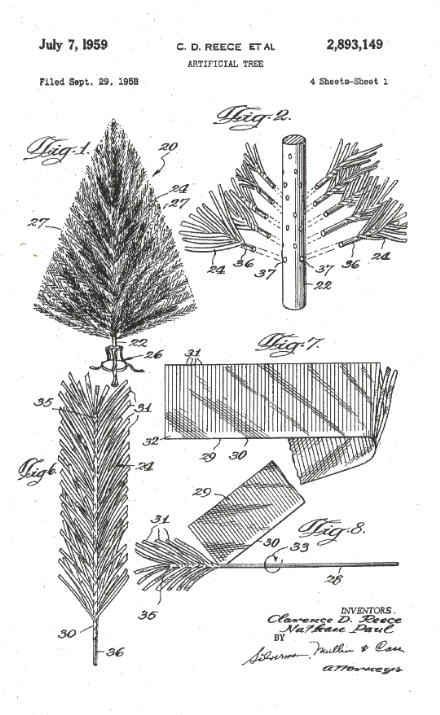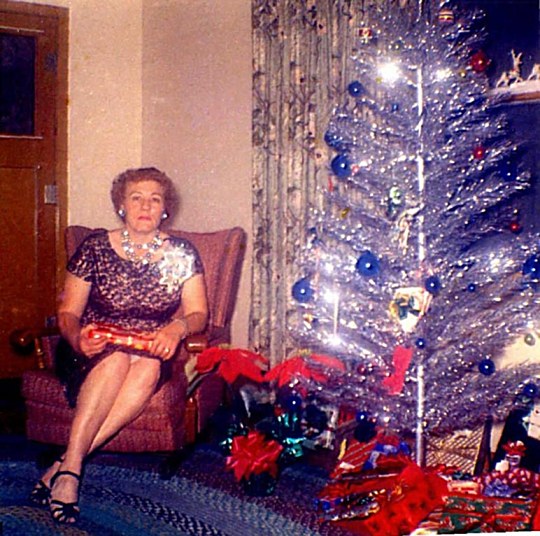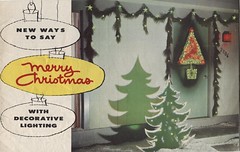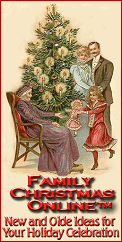
During the years following the
1950 cutoff date of this web site, many new and innovative lighting
outfits hit the market. The most significant of these, the "fairy" or
miniature lights, debuted in the early 1950s and were to become the
accepted form of Christmas lighting by the mid 1980s. They remain so to
this day.
Another significant event had
it's beginnings in December, 1958. Aluminum Specialty Company toy sales
manager Tom Gannon had noticed a small, homemade all metal tree used as a
display in a Ben Franklin Five and Dime store in Chicago, Illinois. He
thought it was a wonderful idea, and presented it to his company in
Manitowoc, Wisconsin right away. At the time, Manitowoc was known as the
Aluminum Cookware Capital of the World, and the company president thought
that Tom's idea was a splendid one. The design department sprang into
action, and by Christmas of 1959, they offered the very first all-aluminum
Christmas tree to a somewhat confused public. After a surprisingly busy
first year of sales, the idea really took off, and by 1960 The Aluminum
Specialty company had perfected their flagship tree: The Evergleam.
Although the company records and archives have long since been lost,
several estimates put the factory output at four million trees during
their 10 year production time from 1959 to 1969.
 The
company never advertised their tree as artificial, but rather insisted
that their offering was simply a "Permanent Tree". It had a sliver
painted wooden trunk with a multitude of holes drilled in it at increasing
angles, so that when each of the hand made branches of the same size was
inserted into them, they would perch upwards, forming the traditional tree
shape. Equipped with a simple aluminum tripod style stand, the trees were
easy to set up and certainly caught one's eye. The
company never advertised their tree as artificial, but rather insisted
that their offering was simply a "Permanent Tree". It had a sliver
painted wooden trunk with a multitude of holes drilled in it at increasing
angles, so that when each of the hand made branches of the same size was
inserted into them, they would perch upwards, forming the traditional tree
shape. Equipped with a simple aluminum tripod style stand, the trees were
easy to set up and certainly caught one's eye.
As is almost always true with a
successful product, imitators soon jumped on the bandwagon, and the market
was flooded with a huge variety of aluminum wonders, not only in the
original silver color, but now in gold, green, blue, a blue and green
combination, a silver with blue tips and even pink!
 Due
to the extreme danger of using electric lights on the highly-conductive
aluminum branches, rotating multicolored floodlights, called color wheels,
were sold to illuminate the trees. A huge variety of these wheels
were offered by all of the Christmas lighting and decoration companies. Due
to the extreme danger of using electric lights on the highly-conductive
aluminum branches, rotating multicolored floodlights, called color wheels,
were sold to illuminate the trees. A huge variety of these wheels
were offered by all of the Christmas lighting and decoration companies.
Trees were offered for sale by
most of the major Christmas lighting companies as well, including NOMA,
Paramount and TIMCO. The heights of the silvery wonders ranged for a tiny
one foot table top tree up to a 7 foot monster. There were even half trees
produced for wall mounting in offices and stores. The variety was
seemingly endless. Along with The Aluminum Specialty Company, other
companies offering the glittery wonders included Star Brand Company in
Portsmouth, Virginia, Regal Electronics in Chicago, Illinois, and
Fairyland Trees in California.
 (Click
to enlarge picture) Website visitor Anna Bates
shares this picture and memories of her mother with us. Referring to
their first aluminum Christmas tree, Anna writes: "I still remember
when Mom brought that thing home in a big cardboard box. Permanent
tree! When she pulled out that painted silver pole, we laughed so
hard we cried. Later that night we all stood in the living room for
the ritual of turning on the color wheel for the first time. We
stood there in amazement watching the tree turn red, yellow --- then
when blue came around a hushed "oooooooh" from all of us. She was
so proud of that thing. In this picture, she is sitting next to her
tree, wearing a matching aluminum corsage, strappy sandals, huge
rhinestone earrings to accentuate her dyed red hair. I loved her so
much. And to think I thought all that stuff was tacky when I was a
teenager! Her name was Nora Bates, and she died from complications
of Alzheimer's disease in April 2003." (Click
to enlarge picture) Website visitor Anna Bates
shares this picture and memories of her mother with us. Referring to
their first aluminum Christmas tree, Anna writes: "I still remember
when Mom brought that thing home in a big cardboard box. Permanent
tree! When she pulled out that painted silver pole, we laughed so
hard we cried. Later that night we all stood in the living room for
the ritual of turning on the color wheel for the first time. We
stood there in amazement watching the tree turn red, yellow --- then
when blue came around a hushed "oooooooh" from all of us. She was
so proud of that thing. In this picture, she is sitting next to her
tree, wearing a matching aluminum corsage, strappy sandals, huge
rhinestone earrings to accentuate her dyed red hair. I loved her so
much. And to think I thought all that stuff was tacky when I was a
teenager! Her name was Nora Bates, and she died from complications
of Alzheimer's disease in April 2003." |

But,
just as quickly as their popularity soared, public interest in the trees
started to fade, due in a major part to a popular television cartoon. The
trees would soon be declared a symbol of the crass commercialism of
Christmas, when, in December of 1965, the first airing of A Charlie Brown
Christmas appeared on CBS. The American public seemed to take to heart the
refusal of Charlie Brown to buy as his symbol of the Yuletide season "the
biggest aluminum tree he could find, maybe even painted pink". As early as
1968, most companies no longer listed them in their catalogs.
Today, collectors will pay a
high price for some of the less common trees, especially in the colors
other than silver. The average selling price for a vintage silver-colored
aluminum tree in good condition is about $15 per foot of height. Expect to
pay a premium price for a pink tree, the rarest of all of the colors
offered. Trees of any color that are especially full, or have the pom-pom
branch ends will also command a premium price. In December, 2000
reproduction trees appeared on the market, and were surprisingly good
sellers. Expect to see more of them offered in future years.
Meanwhile, on the Christmas Lighting Scene
 Incandescent lights continued to rule on the non-aluminum trees of course. But just selling lights for trees wasn't good enough for GE. In the 1950s, and through much of the 1970s, they started including pamphlets describing OTHER decorating projects to do with their light strands. Jeff Carter's online Christmas Lighting Guide Collection at Flickr, shows several examples, some of which are as memorable for the silliness of their suggestions as for their originality. Incandescent lights continued to rule on the non-aluminum trees of course. But just selling lights for trees wasn't good enough for GE. In the 1950s, and through much of the 1970s, they started including pamphlets describing OTHER decorating projects to do with their light strands. Jeff Carter's online Christmas Lighting Guide Collection at Flickr, shows several examples, some of which are as memorable for the silliness of their suggestions as for their originality.
BACK -
Table of Contents
|



































